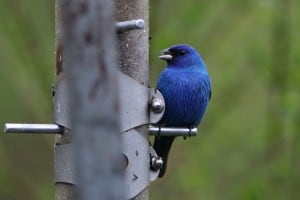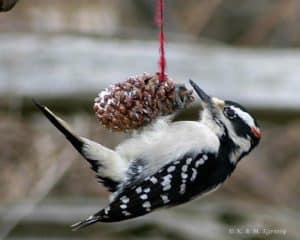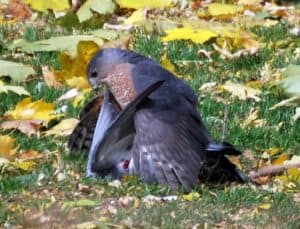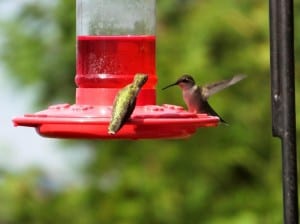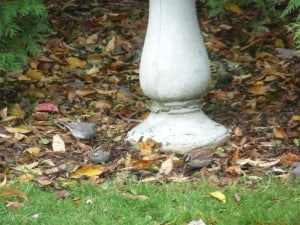When it comes to feeding birds, it’s important to be skeptical of ‘conventional wisdom’. There are a lot of myths out there, some of which might discourage people from putting out feeders. No one with an interest in birds should be missing out on such an entertaining and convenient way to enjoy contact with nature. Feeding wild birds also serves to develop a greater understanding and appreciation for the environment in general. It’s impossible to care about birds without becoming concerned about issues such as climate change and habitat destruction.
The following list highlights some of areas of concern that people have when it comes to feeding birds. I have also included some suggestions to make bird feeding more successful and enjoyable.
1. Over-dependence on feeders. Birds do not depend on any one food source. They need a greater variety of food than feeders alone can provide. For example, studies with chickadees have demonstrated that even removing a feeder in mid‑winter does not result in greater flock mortality than would normally occur in flocks that do not visit feeders. Birds are well able to find other sources of food if feeders are unavailable. Putting out food for the birds can be important during extreme weather events, but birds will not starve if the feeders aren’t filled.
2. Impact on migration: People sometimes fear that feeding birds during the fall migration period might somehow stop them from flying south. Feeders will not keep birds from migrating. Migration is controlled by instinct and by external factors like daylight and weather. In fact, your feeders are providing an energy boost to help them survive these long journeys. I witness the allure of migration every October when hoards of white‑throated sparrows visit our yard. Despite a ready supply of black oil sunflower seed and millet scattered liberally on the ground, all of the birds depart by the end of the month.
3. Hawks at feeders: It’s true that feeding birds might attract a Cooper’s hawk or even a barred owl to your yard. Personally, I feel privileged to witness the drama, even if a mourning dove or house finch pays the price. The raptor’s presence indicates that the food chain is healthy and working as it should. Raptors are also fascinating birds to observe in their own right. If predation becomes too much of a problem, you can simply take your feeders down for a few days and thereby disperse the smaller birds.
4. When to feed: Many people make the mistake of waiting until winter has arrived before putting up their feeders. The greatest bird diversity at feeders actually occurs in the spring and fall. In early October, for example, a dozen or more species may turn up on a given day. The same can be true in late April. I usually start putting out sunflower seed and millet in late September, when large numbers southbound white‑throated and white‑crowned sparrows are passing through. They are easily attracted to our yards if seed is available on the ground. These sparrows come through again in late April and early May on their way north. Rose-breasted grosbeaks and indigo buntings may also show up at feeders in May and are a real treat to see. Grosbeaks are attracted to sunflower seed, while the buntings prefer nyjer seed. By putting out food in the spring and fall, you are also providing a welcome source of energy for the birds’ long flight to or from their wintering grounds.
There is no problem feeding birds in summer, either. I keep my peanut and nyger seed feeders filled all year long. Woodpeckers, nuthatches and chickadees dine on the peanuts, while goldfinches are a constant presence at the nyger seed. If you live in the country near a woodlot, rose-breasted grosbeaks and their young will often come to sunflower feeders during the summer months.
5. Metal perches: There is no reason to be concerned that a bird’s feet might stick to metal feeder perches in winter. The feet are made up mostly of scaly tissue and are well protected against the cold. Blood flow in the feet is minimal, and sweat glands are completely absent. This means that there is no moisture present to freeze to metal.
6. Peanut butter is dangerous: As far as I’m aware, there is no documented evidence that birds can choke on peanut butter. In fact, peanut butter is high in fat and therefore provides a great deal of energy.
7. Hummingbirds: Don’t wait until the warm weather of June to get out your hummingbird feeder. Hummingbirds arrive back in the Kawarthas in early May, when flower nectar is in short supply and frigid weather is still possible. At this time of year, a feeder might actually make a difference to their survival. I also recommend leaving it up until late September, when the last of the hummingbirds departs for Mexico and Central America. Whether the sugar water in the feeder contains red dye is largely irrelevant. The birds don’t need it to find the feeders. As to whether the dye can hurt the birds, the jury still seems to be out. I recommend erring on the side of caution.
8. Scattering seeds: You will attract a lot more bird species by spreading seeds on the ground. Yes, you may lose some to squirrels, but at the same time, you will attract some of the many birds that are strictly ground feeders. Who knows? A fox sparrow or an eastern towhee might even show up. I prefer to use millet to spread on the grass and snow; however, I try to scatter it widely enough so that the squirrels can only glean a small part of it. Scattering the seeds near hedges and other areas of cover seems to work best.
9. Where are the birds? The number and variety of birds coming to feeders varies greatly over the year. Why bird activity is slow at times is not always clear. However, there are several possible explanations. First, many species such as cardinals and house finches travel in flocks in winter and may only frequent a small number of feeders. Yours may not be on their list. The presence of a raptor in the neighbourhood may also explain why fewer birds are present on a given day. Habitat changes in your neighborhood such as trees being cut down can also have an impact. The loss of habitat is the number one cause for the rapidly declining populations of many bird species. Finally, birds like siskins, redpolls and pine grosbeaks can be completely absent in the Kawarthas some years. This is because the wild foods they depend upon – conifer seeds, birch seeds, berries, etc – fluctuate in abundance from year to year. When there is plentiful food available in their boreal forest nesting grounds, they simply stay put. This seems to be the case this year.
10. Window collisions: Feeders do increase the danger of window kills. One way to reduce this problem is to place your feeder within ten feet of window glass. In this way, birds flying away from the feeder won’t build up enough speed to seriously injure or kill themselves, should they hit a window. You will find lots of other ideas for reducing window collisions at allaboutbirds.org
Great Backyard Bird Count
Every year I like to encourage readers to further the cause of science by taking part in the Great Backyard Bird Count (GBBC). Launched in 1998, it was the first online citizen-science project to collect data on wild birds and to display results in near real-time. Now, more than 160,000 people of all ages and walks of life worldwide join the four-day count each February to create an annual snapshot of the distribution and abundance of birds. In 2016, GBBC participants in more than 130 countries counted 5,689 species of birds on more than 162,000 checklists.
This year’s count takes place February 17-20, which is the Family Day weekend. This makes the count a great activity to do with your kids or grandkids. For at least 15 minutes on one or more days of the count, simply tally the numbers and kinds of birds you see. You can count from any location – not just your own backyard. If you’re new to the count, or have not participated since before the 2013, you must create a free online account with eBird to enter your checklists. During the count, you can explore what others are seeing in your area or around the world. Share your bird photos by entering the photo contest, or enjoy images pouring in from across the globe. All the information you need is at gbbc.birdcount.org
